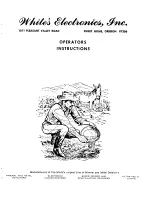
the two captive screws located in the battery cover (do not fully remove these from the cover)
and remove the cover. Inside is the battery holder. Lift out the holder and detach the connector if
it is already fitted. Load it with the eight batteries ensuring that each battery is inserted the
correct way round, (direction of batteries alternating). Roll each individual battery to ensure it is
located correctly and making proper contact. Replace the connector making sure that it is firm
and well seated, and put the loaded holder into the housing. Fit the cover and tighten the two
captive screws finger tight.
Note: Zinc Carbon batteries should not be left in the detector for long periods where they could
leak, so remember to remove them at the end of a day's searching.
BATTERY CHECK
A battery condition indicator is provided on the detector. To do this for the first time prior to
reading the remainder of the operating instructions proceed as follows:-
A) Turn the FREQUENCY control to BATT. CHECK and turn the THRESHOLD control to
1. The meter will indicate in the green area if the batteries are good and in the left or
central position if the batteries need replacing or recharging.
B)
Turn the THRESHOLD control to POWER OFF.
Rechargeable batteries will not read as high into the green as standard batteries even when fully
charged. They also give less indication of discharge on the meter during use.
Checking The Batteries
CS6Pi
BATT.
CHECK
1
CONTROLS AND WHAT THEY DO
The CS6
Pi
has been designed to offer simplicity of use with high, reliable performance.
5






























